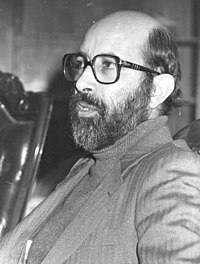Mostafa Chamran: Difference between revisions
No edit summary |
|||
| Line 30: | Line 30: | ||
He was fluent in [[Persian Language|Persian]], [[English Language|English]], [[Arabic Language|Arabic]], [[French Language|French]], and [[German Language|German]]. |
He was fluent in [[Persian Language|Persian]], [[English Language|English]], [[Arabic Language|Arabic]], [[French Language|French]], and [[German Language|German]]. |
||
==Family life== |
|||
He got married to an American girl, they had 3 children, he probably got American citizenship too. More information required here.... |
|||
==Revolutionary activities== |
==Revolutionary activities== |
||
In the late 1970s and early 1980s, Chamran became politically active. He became a leading and founding member of the Islamic revolutionary movement in the [[Middle East]], organizing and training guerrillas and revolutionary forces in [[Algeria]], [[Egypt]], [[Syria]], especially [[Amal Movement]] in southern Lebanon. |
In the late 1970s and early 1980s, Chamran became politically active. He became a leading and founding member of the Islamic revolutionary movement in the [[Middle East]], organizing and training guerrillas and revolutionary forces in [[Algeria]], [[Egypt]], [[Syria]], especially [[Amal Movement]] in southern Lebanon. |
||
Revision as of 15:10, 24 June 2011
Mostafa Chamran | |
|---|---|
 | |
| Allegiance | Iranian Army |
| Years of service | 1978 - 1981 |
| Rank | Minister of Defence |
| Battles/wars | Iran–Iraq War |
Mostafa Chamran Savei (1932 – 21 June 1981) was an Iranian scientist and Shiite Muslim[1] who served as defence minister and member of parliament, as well as commander of paramilitary volunteers in Iran–Iraq War. He was Vice President and Defense minister of Iran. He was killed in action during the course of the war. He helped sayyed Mousa Sadr found the Amal Movement in southern Lebanon and fought alongside Amal guerrillas in the late 1970s.
Education
Born in 1932 in Tehran, he became a young student of Ayatollah Taleqani and Morteza Motahari. He studied at Alborz High School and then graduated from Tehran University.
In the late 1960s, he moved to the United States for higher education, obtaining an M.S. degree from the Texas A&M University[2]. He then went on to obtain his Ph.D. in Electrical Engineering and Plasma Physics in 1963 from the University of California, Berkeley [3].
He was then hired as a senior research staff scientist at Bell Laboratories and NASA's Jet Propulsion Laboratory.
He was fluent in Persian, English, Arabic, French, and German.
Family life
He got married to an American girl, they had 3 children, he probably got American citizenship too. More information required here....
Revolutionary activities
In the late 1970s and early 1980s, Chamran became politically active. He became a leading and founding member of the Islamic revolutionary movement in the Middle East, organizing and training guerrillas and revolutionary forces in Algeria, Egypt, Syria, especially Amal Movement in southern Lebanon.
Return to Iran
With the Islamic Revolution taking place in Iran, Chamran's career took a sharp turn. He was appointed commander of Iran's Pasdaran, as well as Iran's Minister of Defense, personal military aide to Ayatollah Ruhollah Khomeini, and the latter's representative to the Supreme Council of Defense. In March 1980, he was elected into the Majlis of Iran (the Iranian Parliament) as a representative from the city of Tehran.
Death

He was killed in Khuzestan Province on June 21, 1981 as the Iran–Iraq War was raging on. He was later given a hero status and many buildings and streets in Iran and Lebanon, as well a major expressway, were named after him.
References
Video Mustafa Chamran. http://wn.com/Dr_Mustafa_Chamran
External links
- 1932 births
- 1981 deaths
- Iranian military personnel of the Iran–Iraq War
- Army of the Guardians of the Islamic Revolution officers
- Military personnel killed in action
- University of Texas at Austin alumni
- University of California, Berkeley alumni
- Alborz High School alumni
- Iranian humanitarians
- Iranian Muslims
- Iranian scientists
- Freedom Movement of Iran politicians
- Defence ministers of Iran
